

Robert Reich (The Three Biggest Right-Wing Lies About Poverty) You often hear inequality has widened because globalization and technological change have made most people less competitive, while making the best educated more competitive.

Child Trends Study Shows U.S. Has a High Poverty Rate, Spends Little on Family Benefits. One measure of how much governments prioritize children and families is how much they spend on things like child allowances, daycare, and child-tax credits.

Inside a longer report on global child well-being, out this week from the nonprofit Child Trends, lies this surprising tidbit: The U.S. has a higher proportion of children living in poverty than most other high-income countries, and it spends just 0.7 percent of its GDP on benefits for families—a fraction of what other middle- and high-income countries spend. “Among 21 countries in the study,” the organization writes in an accompanying statement, “the U.S. ranks second-to-last in the percentage of its GDP spent on benefits for families, despite one of the highest relative child poverty rates of the comparable high-income countries.”
(Turkey technically ranks last, but only because its data is missing.) Spending on Family Benefits by % of GDP, by Country Israel spent 2 percent, despite its large military budget. Gary Haugen: The hidden reason for poverty the world needs to address now. Glogin?mobile=1&URI= America’s Biggest Problem Isn't Income Inequality, It's Concentrated Poverty and Segregation. Thanks to New York Mayor Bill de Blasio, economist Thomas Piketty, and, of course, the Occupy Movement, inequality is firmly on the national agenda.
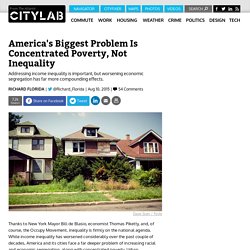
While income inequality has worsened considerably over the past couple of decades, America and its cities face a far deeper problem of increasing racial and economic segregation, along with concentrated poverty. Urban sociologists like Harvard’s Robert Sampson and NYU’s Patrick Sharkey have shown how concentrated neighborhood poverty shapes everything from higher crime rates to limited social mobility for the people—and especially the children—who live in these neighborhoods.
As my Atlantic colleague Alana Semuels has detailed, a new Century Foundation study from Paul Jargowsky, director of the Center for Urban Research and Urban Education at Rutgers University, reveals the devastating growth of geographically concentrated poverty and its connection to race across America. The Statistics. 87 Things Only Poor Kids Know. Kids living in poverty don’t have a lot of money — or options.
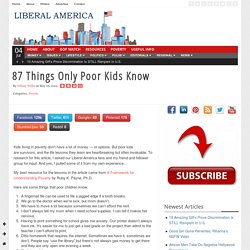
But poor kids are survivors, and the life lessons they learn are heartbreaking but often invaluable. I get food stamps, and I’m not ashamed — I’m angry. My name is Christine, and I get food stamps.
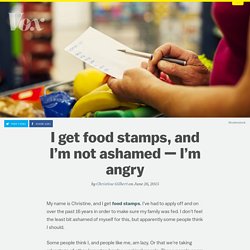
I've had to apply off and on over the past 16 years in order to make sure my family was fed. I don't feel the least bit ashamed of myself for this, but apparently some people think I should. Some people think I, and people like me, am lazy. Or that we're taking advantage of other (smarter, harder-working) people. The Pencilsword: On a plate. You know these, right?! 11 house hold names that worked with the Nazis during WWII. 5 Common Assumptions You Never Realized Were Classist. The US payday loans crisis: borrow $100 to make ends meet, owe 36 times that sum. I am driving down Route 180 in St Louis, Missouri, past empty plazas and vacant shops, down a stretch of road that terminates in an abandoned mall.
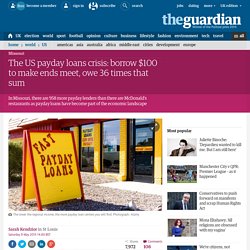
Yet on this road are promises of wealth: “Loans Up to $10,000”, says one sign. “Advances up to $500” says another. In contrast to the faded retailers surrounding them, these new storefronts are cheerful, decorated with pictures of flowers or gold or the American flag. This is the alternative economy of payday loans, which has sprung up where the old economy has died. In St Louis, a payday loan is something which you are either intimately familiar with or completely oblivious to. Think the poor don’t pay taxes? This chart proves you very wrong.
One of the stranger conservative tax talking points is the claim that the tax code is somehow unfair to rich people, who are unduly burdened by the progressive income tax.
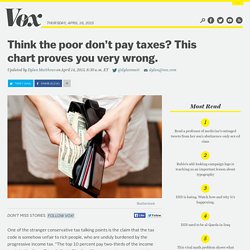
"The top 10 percent pay two-thirds of the income tax," the Heritage Foundation's Stephen Moore notes in a representative piece. "And the bottom 50 percent — all Americans with an income below the median — pay just 3 percent of the income tax. " Sen. Rand Paul (R-KY) made a similar argument in his 2013 and 2014 budgets, which included a flat tax to make "the system more efficient and fair by broadening the tax base, letting everyone contribute to their government instead of a few people contributing for everyone.
" Leaving aside the fact that this is exactly how a progressive tax system is supposed to work, this analysis has a big conceptual flaw: it only focuses on federal income taxes. (Center for Tax Justice) (Citizens for Tax Justice) Again, this is mildly progressive, but only very mildly. The big lie about families on welfare: they don't work. The debate over public benefits almost always treats "welfare" and "work" as counterparts to each other.
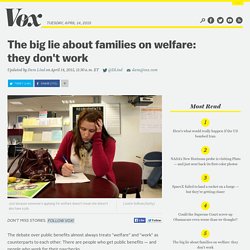
There are people who get public benefits — and people who work for their paychecks. But it turns out a lot of those people overlap: a majority of public benefits go to working families, a new analysis from two Berkeley economists finds. Their work shows that $152 billion in public programs like Medicaid and welfare — 56 percent of overall spending — goes toward supporting low-wage workers. As the chart shows, the federal Earned Income Tax Credit goes overwhelmingly to working families — they're about three-quarters of enrollees, and they get 81 percent of the $67 billion the program hands out.
The rich get government handouts just like the poor. Here are 10 of them. A floating tax shelter photographed in its natural habitat.
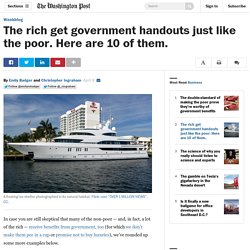
Flickr user "OVER 1 MILLION VIEWS", CC. The double-standard of making the poor prove they’re worthy of government benefits. The actual contents of a Rhode Island woman's cupboard after two shopping trips paid for with food stamps.

It’s Not the Inequality; It’s the Immobility. Photo Income inequality and economic immobility are often lumped together, but they shouldn’t be. Consider the two concepts positively: Income equality is about bridging the gap between the rich and the poor, while economic mobility is about elevating the poor as rapidly as possible. Finding ways to increase economic mobility should be our greater concern. For instance, while we have talked incessantly about the disproportionate gains of the top 1 percent, the wage slowdown in the United States in recent decades is a bigger problem for most people. Income is a Poor Measure of American Inequality. I’d hope that someone who has written a book about “What Shapes Our Fortunes” would have had Sociology 101 where he would have learned the fundamentally different ways that income and wealth work in our economy.
But apparently not. People on Food Stamps Make Healthier Grocery Decisions Than Most of Us. Which is why we shouldn't tell them what to buy. —Tom Philpott on Mon. March 9, 2015 5:55 AM PDT. Why Inequality Persists in America - The New Yorker. For about a century, economic inequality has been measured on a scale, from zero to one, known as the Gini index and named after an Italian statistician, Corrado Gini, who devised it in 1912, when he was twenty-eight and the chair of statistics at the University of Cagliari. If all the income in the world were earned by one person and everyone else earned nothing, the world would have a Gini index of one.
If everyone in the world earned exactly the same income, the world would have a Gini index of zero. The United States Census Bureau has been using Gini’s measurement to calculate income inequality in America since 1947. Why Do So Many Rich People Think They're in the Middle Class? Everybody wants to be rich, but nobody wants to admit to being rich.
That's the takeaway from recent articles by the New York Times' Josh Barro and David Leonhardt. Both discuss the challenge of getting people who make far more money than the average American to recognize that no amount of complaining about how expensive their life is wins them a spot in the middle class. Untitled. Wealth inequality can be described as the unequal distribution of assets within a population. The United States exhibits wider disparities of wealth between rich and poor than any other major developed nation. Defining Wealth. One Startling GIF Shows How Much the US Spends on Imprisoning vs. Educating People. Hardly a day goes by without a member of the media or policy world pronouncing that America's education system is in dire straits.
The unbearable burden of being poor. Who Benefits from Government Programs? DN! 10 Poverty Myths, Busted. Parable of the Polygons - a playable post on the shape of society. Linda_tirado_on_the_realities_of_living_in_bootstrap_america_daily_annoyances. Photo by tsuacctnt via Flickr. 25 Horrifying Images of the "Free" Market at Work. When economists talk about how a market "regulates itself," what they mean is that markets reach an equilibrium between supply and demand. A Call to Conscience. Robert Reich: 10 ways to close the inequality gap.
Raising Taxes on Corporations that Pay Their CEOs Royally and Treat Their Workers Like Serfs Until the 1980s, corporate CEOs were paid, on average, 30 times what their typical worker was paid. Since then, CEO pay has skyrocketed to 280 times the pay of a typical worker; in big companies, to 354 times. 6 Activities Exploring Prejudice and Discrimination. Five stereotypes about poor families and education. Profits At High, Wages At Low. The cost of child poverty: $500 billion a year. The United States has the second-highest child poverty rate among the world’s richest 35 nations, and the cost in economic and educational outcomes is half a trillion dollars a year, according to a new report by the Educational Testing Service. The report, called “Poverty and Education, Finding the Way Forward,” says that 22 percent of the nation’s children live in relative poverty, with only Romania having a higher rate in the group of 35 nations.
(Next are Latvia, Bulgaria, Spain, Greece, Italy, Lithuania, Japan and Portugal, it says; the country with the lowest child poverty rate is Iceland, and the second lowest is Finland.) The report notes, though, that the official U.S. poverty rate is incomplete, and that other data show that 48 percent of the population had incomes in 2011 that are considered inadequate or not livable. (Relative poverty rates refer to people with incomes below 50 percent of the poverty threshold.)
The report was written by Richard J. Viral Video Shows the Extent of U.S. Wealth Inequality. Connect The Dots For Democracy, Connect The Dots USA. Www.connectthedotsusa.com/pdf/WheresMyJobSlides.pdf. Poor Students Struggle as Class Plays a Greater Role in Success. 'The Hunger Games' Are Here. And They Are Very, Very Real. Films. Why Twinkies Cost Less Than Carrots. Tracy Ore's Life Happens.
Www.cdc.gov/nchs/data/hus/hus11.pdf#022. Front-Page Privilege: 0.2 Percent of Immigration Stories Written By Latinos - The ITT List. Rethinking American Poverty. Graphing America. How The Poor, The Middle Class And The Rich Spend Their Money : Planet Money.